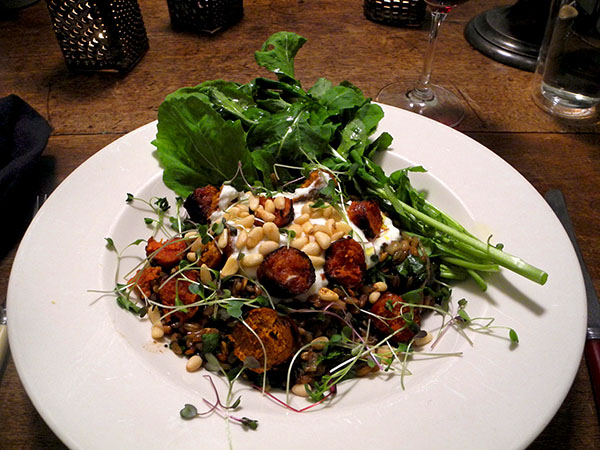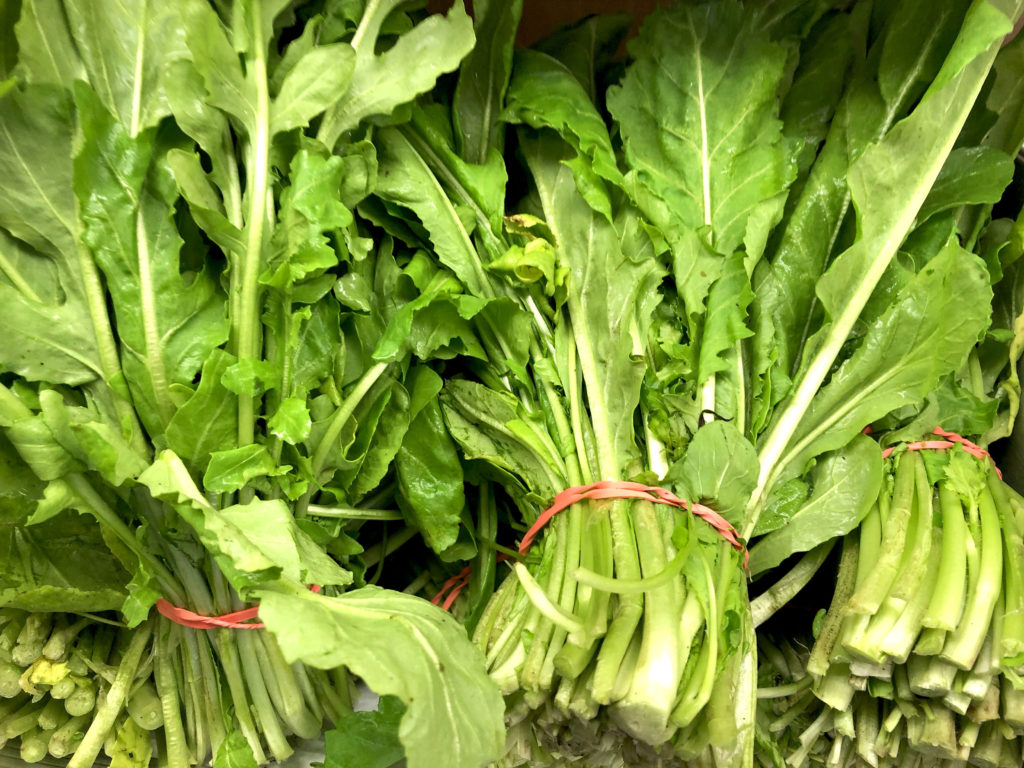
I love food that is not a part of the Western tradition, but if you know me, or have been hanging around this food blog, you probably know my cooking almost never strays far from the European canon, or some new interpretations of it, by myself or found. I always make the excuse that my small kitchen and larder doesn’t have room for the supplies and equipment of another tradition, one that’s seriously removed from the one I work with now.
But that doesn’t mean I’m happy with the situation.
Last night I put together a very modest meal whose inspiration definitely comes from a world beyond Europe, although I have to add, just barely beyond. I think I pulled it off pretty well, but I have to apologize to the entire Levantine and North African world: I included two pork sausages in the freekeh. It was because they were there, leftovers from 2 different, earlier meals, and this seemed like it might be the only opportunity I’d have to use them; it was probably the best opportunity, in any case. As someone who is not now, and never has been concerned with observing either Jewish dietary laws or Islamic dietary laws, the combination seemed, well, ..’meet‘. Does it help my cause if I add that the very spicey sausage, that I used, a local chorizo, used looked, smelled, and tasted very much like lamb, which would be something that was often a part of a serving of freekeh where the dish originated?
I used a recipe for Freekeh pilaf, from Yotam Ottolenghi’s beautiful site, Ottolenghi Limited. Of course there was no suggestion there that any kind of sausage might be included in the dish, so I took full responsibility for the transgression.
And yet!
I learned later that Ottolenghi himself has published recipes which include pork, even chorizo specifically; and then I really began to appreciate his attitude toward good food: “In 2006, Ottolenghi began writing a weekly column for The Guardian titled ‘The New Vegetarian,’ though he himself is not a vegetarian and has sometimes noted where a vegetable-centric recipe would pair well with a particular cut of meat.” – that from his Wikipedia entry.

I also arranged a spray of delicious local arugula on the plate, although it too was not a part of the original recipe, although it would not be out of order.
A final note: In the continuing dinner series, this meal was also completely ‘one-arm-in-a-sling-friendly’, after I had cut the arugula leaves on Barry’s plate into one or two-inch segments.
- the source of the ingredients in the dish last night (with slight variations in kind from the basic recipe, plus the addition of the sausage and a micro green garnish) were: 3 alliums of 3 different kinds, an ‘Expression’ sweet onion, a red onion, and a red shallot, in descending size, and all from Norwich Meadows Farm; Organic Valley ‘Cultured Pasture Butter’; Portuguese olive oil from Whole Foods Market; Freekeh Roasted Green Spelt, produced by Lakeview Organic Grain, Penn Yan, N.Y. (a part of the Greenmarket Regional Grains Project); ‘Simply Organic’ whole cinnamon and allspice from Whole Foods, freshly-ground by hand in the kitchen; Better Than Bullion seasoned low-sodium vegetable stock from Whole Foods Market; Millport Dairy Farm plain yoghurt; organic lemon juice from Whole Foods Market; Rocambole garlic from Keith’s Farm; Italian parsley from Whole Foods Market ; mint from John D, Madura Farm; lovage from Two Guys from Woodbridge; pine nuts from Buon Italia; coarse ground Baleine sea salt from Whole Foods Market; freshly-ground whole black pepper from Whole Foods Market; chorizo sausage from Millport Dairy Farm added to the finished freekeh; and rainbow micro greens from Two Guys from Woodbridge as a garnish on top
- arugula from Lani’s Farm, dressed with a little olive oil, Maldon salt, and freshly-ground black pepper
- the wine was an Italian (Sardinia) red, Argiolas, Monica di Sardegna ‘Perdera’ 2015, from Flatiron Wines
- the music was Mary Ellen Childs’ album, ‘Dream House’, described on ‘Innova‘, the American Composers Forum label’s site, as “HGTV meets Koyanisqaatsi”